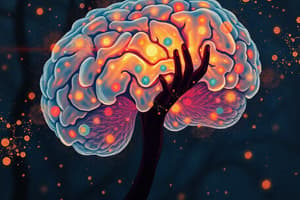Podcast
Questions and Answers
What are the essential components contributing to our perception and experience of pain?
What are the essential components contributing to our perception and experience of pain?
- Cerebellum, medulla oblongata, and pons
- Hippocampus, amygdala, and hypothalamus
- Somatosensory cortex, insula, and anterior cingulate cortex (correct)
- Frontal lobe, parietal lobe, and occipital lobe
Which neurotransmitters act as natural painkillers by inhibiting nociceptive signal transmission?
Which neurotransmitters act as natural painkillers by inhibiting nociceptive signal transmission?
- Dopamine and serotonin
- Endorphins and enkephalins (correct)
- Glutamate and GABA
- Acetylcholine and norepinephrine
Which neuropeptide can enhance pain sensitivity by increasing neurotransmitter release from primary afferent neurons?
Which neuropeptide can enhance pain sensitivity by increasing neurotransmitter release from primary afferent neurons?
- Neurokinin A
- Substance P
- Calcitonin gene-related peptide (CGRP) (correct)
- Vasoactive intestinal peptide (VIP)
What needs to be examined to understand nociception's transmission according to the text?
What needs to be examined to understand nociception's transmission according to the text?
What will further research into nociception mechanisms provide insights into, according to the text?
What will further research into nociception mechanisms provide insights into, according to the text?
What is the role of peripheral nerve endings in nociception?
What is the role of peripheral nerve endings in nociception?
Which neurotransmitters are involved in the communication between primary afferent neurons and secondary neurons in the spinal cord during nociception?
Which neurotransmitters are involved in the communication between primary afferent neurons and secondary neurons in the spinal cord during nociception?
What is the main function of primary afferent neurons in nociception transmission?
What is the main function of primary afferent neurons in nociception transmission?
What is the primary role of the thalamus in nociception transmission?
What is the primary role of the thalamus in nociception transmission?
Which statement accurately describes the transmission of pain signals at the level of primary afferent neurons?
Which statement accurately describes the transmission of pain signals at the level of primary afferent neurons?
What happens once nociceptive signals reach the central nervous system?
What happens once nociceptive signals reach the central nervous system?
Flashcards are hidden until you start studying
Study Notes
Nociception: Understanding Its Transmission
Introduction
Nociception refers to the detection and transmission of pain signals from the peripheral nerve endings to the central nervous system. This intricate process involves various mechanisms that help identify and classify pain stimuli, ensuring an appropriate response from the organism.
Peripheral Nerve Endings
Peripheral nerve endings play a crucial role in transmitting nociceptive signals. These specialized fibers contain a variety of receptors sensitive to different types of stimuli, including heat, cold, pressure, or chemicals released due to tissue injury. Once activated, these receptors generate electrical impulses that travel through the nerves to the central nervous system.
Transmission in the Spinal Cord
The first step in nociception transmission occurs at the level of spinal cord neurons called primary afferent neurons. These neurons receive input from peripheral nerve endings and transmit signals to secondary neurons within the spinal cord. This process involves neurotransmitters such as glutamate and substance P, which facilitate communication between neurons.
Central Processing in the Brain
The second stage of nociception transmission involves the relay of information from the spinal cord to higher brain centers. The thalamus acts as a gateway, integrating sensory inputs and relaying them to various cortical areas responsible for processing pain stimuli. Structures like the somatosensory cortex, insula, and anterior cingulate cortex are essential components of this pathway, contributing to our perception and experience of pain.
Modulation by Neurotransmitters and Receptors
Numerous neurotransmitters and receptors modulate nociception throughout its transmission. Some neurotransmitters, such as endorphins and enkephalins, act as natural painkillers by inhibiting nociceptive signal transmission. On the other hand, certain neuropeptides, like calcitonin gene-related peptide (CGRP), can enhance pain sensitivity by increasing neurotransmitter release from primary afferent neurons.
In summary, understanding nociception's transmission requires examining the intricate interactions between peripheral nerve endings, the spinal cord, and higher brain centers. Further research into these mechanisms will provide insights into potential therapies for managing chronic pain conditions and improving overall quality of life.
Studying That Suits You
Use AI to generate personalized quizzes and flashcards to suit your learning preferences.




